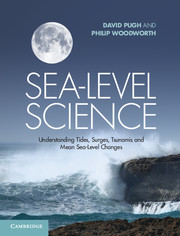Book contents
- Frontmatter
- Contents
- Preface
- List of acronyms
- List of main symbols
- Chapter 1 Introduction
- Chapter 2 Sea-level measuring systems
- Chapter 3 Tidal forces
- Chapter 4 Tidal analysis and prediction
- Chapter 5 Tidal dynamics
- Chapter 6 Shallow-water and coastal tides
- Chapter 7 Storm surges, meteotsunamis and other meteorological effects on sea level
- Chapter 8 Tsunamis
- Chapter 9 Spatial variations in sea level
- Chapter 10 Mean sea-level changes in time
- Chapter 11 Sea-level changes in time to do with the solid Earth
- Chapter 12 Sea-level applications
- Chapter 13 Sea level and life
- Appendix A Basic hydrostatic and hydrodynamic equations
- Appendix B Currents
- Appendix C High and low water times and heights from harmonic constituents
- Appendix D Theoretical tidal dynamics
- Appendix E Legal definitions in the coastal zone
- Glossary
- Index
- References
Chapter 1 - Introduction
Published online by Cambridge University Press: 05 May 2014
- Frontmatter
- Contents
- Preface
- List of acronyms
- List of main symbols
- Chapter 1 Introduction
- Chapter 2 Sea-level measuring systems
- Chapter 3 Tidal forces
- Chapter 4 Tidal analysis and prediction
- Chapter 5 Tidal dynamics
- Chapter 6 Shallow-water and coastal tides
- Chapter 7 Storm surges, meteotsunamis and other meteorological effects on sea level
- Chapter 8 Tsunamis
- Chapter 9 Spatial variations in sea level
- Chapter 10 Mean sea-level changes in time
- Chapter 11 Sea-level changes in time to do with the solid Earth
- Chapter 12 Sea-level applications
- Chapter 13 Sea level and life
- Appendix A Basic hydrostatic and hydrodynamic equations
- Appendix B Currents
- Appendix C High and low water times and heights from harmonic constituents
- Appendix D Theoretical tidal dynamics
- Appendix E Legal definitions in the coastal zone
- Glossary
- Index
- References
Summary
Prospero: ‘. . .ye that on the sands with printless foot
Do chase the ebbing Neptune and do fly him
When he comes back’
Shakespeare, The Tempest
Sea levels are always changing, for many reasons. Some changes are rapid while others take place very slowly. The changes can be local, or extend globally. This book is about the science of these changes.
In this first chapter we outline what constitutes sea-level science. A brief account of the development of scientific ideas is followed by an outline of how sea levels are affected by a wide range of physical forces and processes. Finally we give some basic definitions, and discuss the fundamental statistics of sea levels as time series.
Background
Living by the sea has many benefits. Statistics show that about half the global population lives within 100 km of the sea. Most of the world’s largest cities are on or near the ocean. Ninety per cent of all global trade is carried by sea. The coast offers possibilities of both trade and travel, and increasingly of water-based recreation. Natural geological processes have often conspired to create flat and fertile land near to the present sea level, to which people are drawn or driven to settle.
- Type
- Chapter
- Information
- Sea-Level ScienceUnderstanding Tides, Surges, Tsunamis and Mean Sea-Level Changes, pp. 1 - 16Publisher: Cambridge University PressPrint publication year: 2014
References
- 1
- Cited by



